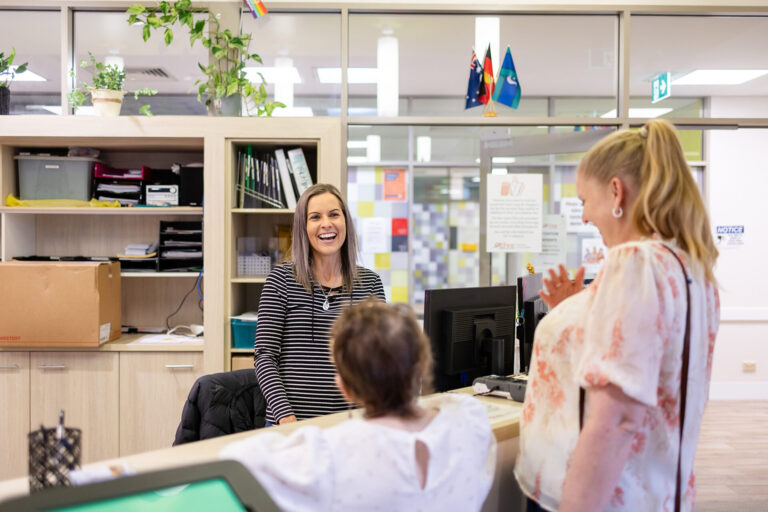
Care Partnership – Diabetes (CP-D) services in Western NSW support improved patient access to clinical care, professional development for health practitioners, GP practice and ACCHS-led services, and health system improvements.
People living with type 2 diabetes and the health practitioners who support them can access a range of clinical, mentoring and navigation services supported by CP-D.

Western NSW Diabetes Hub
Type 2 Diabetes Case Conferencing
Virtual endocrinologist advice for patients, their GPs and multidisciplinary teams in Western NSW LHD are available. These sessions are designed to increase access to specialist advice for patients living with type 2 diabetes and to enhance skills for local health practitioners to manage their ongoing care.
GP practices and ACCHSs in Western NSW are eligible to book GP-Endocrinology sessions. CP-D has engaged two endocrinology providers, MetaDiab and Western Sydney Diabetes eCare, that offer bulk-billed telehealth case conferences with GPs, patients and other health practitioners.
Email the Western NSW Diabetes Hub for information on booking GP-endocrinology sessions and/or to express interest in contributing to the local design of this service.



CP-D has limited seed funding to support the establishment of GP practice or ACCHS-led models of care or quality improvement projects that are centred on improving care for patients with type 2 diabetes.
The program has capacity to support approximately 15 practices and ACCHOs to design and implement initiatives that meet practice or ACCHS population needs. Supported models include:
The process for identifying GP practices and ACCHSs that will design and deliver these models is being developed. The program will likely prioritise services that have substantial type 2 diabetes needs in their practice population or local community and are interested and have capacity to implement a model before June 2026.


The CP-D program supports a range of professional development services for health professionals in Far West and Western NSW who provide care for people living with type 2 diabetes.
The CP-D program works with partners to deliver upskilling events for health professionals who have a broad or specialised role providing care for people with type 2 diabetes in Far West and Western NSW.
Professional development events provided so far include a series of upskilling workshops for non-clinical health professionals; diabetes education sessions for clinicians pursuing CDE qualifications and Aboriginal health practitioners; and the Type 2 Diabetes ECHO series.
Information about relevant professional development events can be viewed on the WNSW PHN’s Upcoming Events page, or on the Rural Health Training Calendar by searching for ‘diabetes’. You can also choose ‘diabetes’ as a professional interest in your Rural Health Pro profile to make sure you see diabetes related events.
Project ECHO® (Extension for Community Healthcare Outcomes) sessions support peer virtual learning for health practitioners through case discussions. Two series of Type 2 Diabetes ECHO sessions have already been delivered and more are planned for GPs and primary health practitioners. These sessions support clinicians’ access to evidence-based, multidisciplinary information for their patients by discussing patient cases with a panel of experts and peers. An introductory video explaining the Project ECHO® model is available here.
Project ECHO® sessions can offer:
Information about upcoming ECHO sessions can be found on WNSW PHN’s Upcoming Events page and the Rural Health Training Calendar.
Please write to echonetwork@wnswphn.org.au if you would like to participate in an upcoming ECHO session, request a topic or patent case study, or contribute on the panel.
The CP-D program team is actively looking to support health professionals in Western and Far West NSW to provide quality diabetes care for communities in the region. This includes identifying and responding to:
The program is exploring supports for these regions’ diabetes educator workforce, mentors of those in-training, and linking newly qualified diabetes educators to roles where they can utilise their skills.
If you would like to raise a workforce need or solution, contribute to governance or evaluation, or other opportunity, please write to westernT2DM@nswrdn.com.au.


CP-D takes a whole-of-system approach on access to care by supporting the provision of coordinated care systems through establishment and use of HealthPathways, INCA and other digital tools.
HealthPathways is a web-based portal for health practitioners that:
The diabetes pages on HealthPathways have been localised for the Far West and Western NSW regions and will continue to be updated.
Health practitioners can login or register to access localised HealthPathways or email HealthPathways for more information.
Inca is a secure web portal and mobile platform that allows you to create patient-centred Medicare-compliant GP Management Plans and Team Care Arrangements to:
To inquire about using Inca, please email our Digital Health Team.
Practices can receive customised practice reports every six months which shows how your patient population is utilising the broader health system, including GP and hospital presentations. The Lumos program provides insights into patient pathways through the NSW health system by linking de-identified data from general practice with other health service data. Learn more about Lumos here.
In addition to practice population insights for practices, Lumos data will be utilised to support CP-D quality improvement and evaluation.
To inquire about using Lumos, please email our Digital Health Team.
Participating GP practices and ACCHSs have free access to the healthdirect Video Call platform to help support access to care for rural and remote communities.
Powered by the COVIU system and administered by the WNSW PHN digital health team, the healthdirect Video Call platform is a secure, private platform and all calls are fully encrypted making it compliant for many clinical consultations.
To register a healthdirect Video Call account, please email our Digital Health Team.


The Care Partnership – Diabetes program is a collaboration between the Western NSW Local Health District, the Far West Local Health District, the Western NSW Primary Health Network and Rural Doctors Network.
